#new soil
Text
Speaking of UK jazz, the new Ill Considered album Precipice is out today as well, from New Soil
Ill considered are a band comprising of musicians interacting with each other to create freely improvised music, based loosely around simple pre-written themes or composed on the spot. Deep grooves and plaintive melodies ranging from whispered chants to monstrous climaxes, the group react to the mood of the audience and the sonics of the room to create music that is unique to the moment.
youtube
Ahead of its release check out an extended, improvised session featuring Ill Considered and a group of special guests recorded down at Total Refreshment Centre to kick off a new chapter their new musical journey. Precipice (Live) features improvisations from:
Idris Rahman, Pete Wareham, Buster Woodruff-Bryant, Art Themen, James Mollison, Nathaniel Cross, Theon Cross, James Yglesias
8 notes
·
View notes
Text
"Many people know about the Yellowstone wolf miracle. After wolves were reintroduced to the national park in the mid-1990s, streamside bushes that had been grazed to stubble by out-of-control elk populations started bouncing back. Streambank erosion decreased. Creatures such as songbirds that favor greenery along creeks returned. Nearby aspens flourished.
While there is debate about how much of this stemmed from the wolves shrinking the elk population and how much was a subtle shift in elk behavior, the overall change was dramatic. People were captivated by the idea that a single charismatic predator’s return could ripple through an entire ecosystem. The result was trumpeted in publications such as National Geographic.
But have you heard about the sea otters and the salt marshes? Probably not.
It turns out these sleek coastal mammals, hunted nearly to extinction for their plush pelts, can play a wolf-like role in rapidly disappearing salt marshes, according to new research. The findings highlight the transformative power of a top predator, and the potential ecosystem benefits from their return.
“It begs the question: In how many other ecosystems worldwide could the reintroduction of a former top predator yield similar benefits?” said Brian Silliman, a Duke University ecologist involved in the research.
The work focused on Elk Slough, a tidal estuary at the edge of California’s Monterey Bay. The salt marsh lining the slough’s banks has been shrinking for decades. Between 1956 and 2003, the area lost 50% of its salt marshes.
Such tidal marshes are critical to keeping shorelines from eroding into the sea, and they are in decline around the world. The damage is often blamed on a combination of human’s altering coastal water flows, rising seas and nutrient pollution that weakens the roots of marsh plants.
But in Elk Slough, a return of sea otters hinted that their earlier disappearance might have been a factor as well. As many as 300,000 sea otters once swam in the coastal waters of western North America, from Baja California north to the Aleutian Islands. But a fur trade begun by Europeans in the 1700s nearly wiped out the animals, reducing their numbers to just a few thousand by the early 1900s. Southern sea otters, which lived on the California coast, were thought to be extinct until a handful were found in the early 1900s.
In the late 1900s, conservation organizations and government agencies embarked on an effort to revive the southern sea otters, which remain protected under the Endangered Species Act. In Monterey Bay, the Monterey Bay Aquarium selected Elk Slough as a prime place to release orphaned young sea otters taken in by the aquarium.
As the otter numbers grew, the dynamics within the salt marsh changed. Between 2008 and 2018, erosion of tidal creeks in the estuary fell by around 70% as otter numbers recovered from just 11 animals to nearly 120 following a population crash tied to an intense El Niño climate cycle.
While suggestive, those results are hardly bulletproof evidence of a link between otters and erosion. Nor does it explain how that might work.
To get a more detailed picture, the researchers visited 5 small tidal creeks feeding into the main slough. At each one, they enclosed some of the marsh with fencing to keep out otters, while other spots were left open. Over three years, they monitored the diverging fates of the different patches.
The results showed that otter presence made a dramatic difference in the condition of the marsh. They also helped illuminate why this was happening. It comes down to the otters’ appetite for small burrowing crabs that live in the marsh.
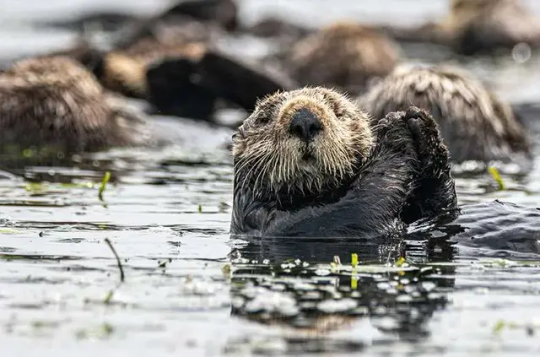
Adult otters need to eat around 25% of their body weight every day to endure the cold Pacific Ocean waters, the equivalent of 20 to 25 pounds. And crabs are one of their favorite meals. After three years, crab densities were 68% higher in fenced areas beyond the reach of otters. The number of crab burrows was also higher. At the same time, marsh grasses inside the fences fared worse, with 48% less mass of leaves and stems and 15% less root mass, a critical feature for capturing sediment that could otherwise wash away, the scientists reported in late January in Nature.
The results point to the crabs as a culprit in the decline of the marshes, as they excavate their holes and feed on the plant roots. It also shows the returning otters’ potential as a marsh savior, even in the face of rising sea levels and continued pollution. In tidal creeks with high numbers of otters, creek erosion was just 5 centimeters per year, 69% lower than in creeks with fewer otters and a far cry from earlier erosion of as much as 30 centimeters per year.
“The return of the sea otters didn’t reverse the losses, but it did slow them to a point that these systems could restabilize despite all the other pressures they are subject to,” said Brent Hughes, a biology professor at Sonoma State University and former postdoctoral researcher in Silliman’s Duke lab.
The findings raise the question of whether other coastal ecosystems might benefit from a return of top predators. The scientists note that a number of these places were once filled with such toothy creatures as bears, crocodiles, sharks, wolves, lions and dolphins. Sea otters are still largely absent along much of the West Coast.
As people wrestle to hold back the seas and revive their ailing coasts, a predator revival could offer relatively cheap and effective assistance. “It would cost millions of dollars for humans to rebuild these creek banks and restore these marshes,” Silliman said of Elk Slough. “The sea otters are stabilizing them for free in exchange for an all-you-can-eat crab feast.”"
-via Anthropocene Magazine, February 7, 2024
#otters#sea otters#conservation#erosion#coastal erosion#coastline#marshes#saltwater#marine science#marine biology#marine animals#sea creatures#ocean#sustainability#soil erosion#erosion control#crab#good news#hope
3K notes
·
View notes
Text
I should be celebrated for mother’s day…
#mother of 15 plants#where’s my breakfast in bed?#i literally play the piano and bass for you guys everyday#clean the leaves#new soil#pretty pots with pretty colours#lots of sunlight#nice water#and nothing in return#pffff
1 note
·
View note
Text

“What makes their collaboration so interesting is how Colleen does so many different things depending on the tone and direction of the story,” said curator Kim Munson. “There are so many visual references and touchpoints, and so much range to her style.”
New retrospective of @colleendoran’s work with @neil-gaiman appears in Forbes (!) in time for the opening of the Colleen Doran Illustrates Neil Gaiman exhibition at NYC’s Society of Illustrators.
#illustration#colleen doran#neil gaiman#Chivalry#troll bridge#snow glass apples#A Distant Soil#new york city#nyc#society of illustrators#mocca#mocca arts fest
2K notes
·
View notes
Text
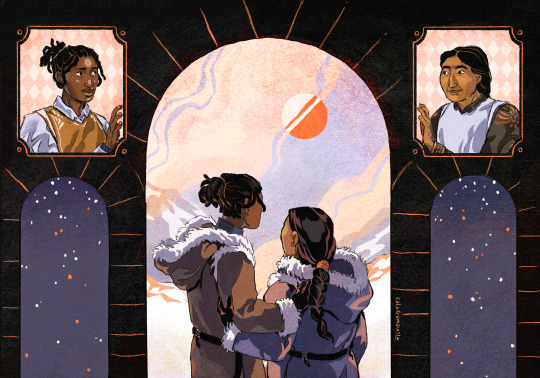
I needed to do some proper art for Le Guin's The Left Hand of Darkness, which has shaken me so so deeply.
#taishe art#the left hand of darkness#thinking about how the planet's name probably translates to Dark....#gethen is the world and getheny is one of the only literally translated words we get. it means new moon or lit. 'darkness'#i don't believe the dark in gethen means winter because they don't have axial tilt seasons - so no longer nights! i think it's a#soil/burial/birth metaphor. creation unfinished and all that yaknow
2K notes
·
View notes
Text

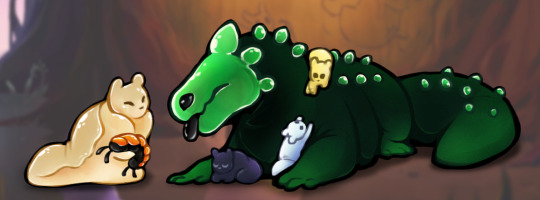
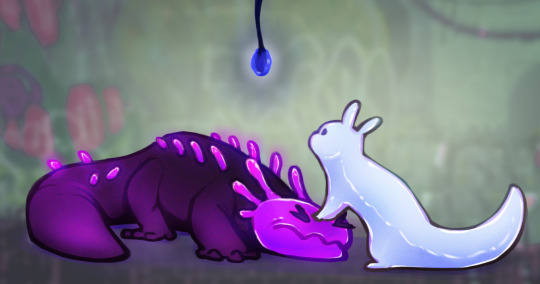

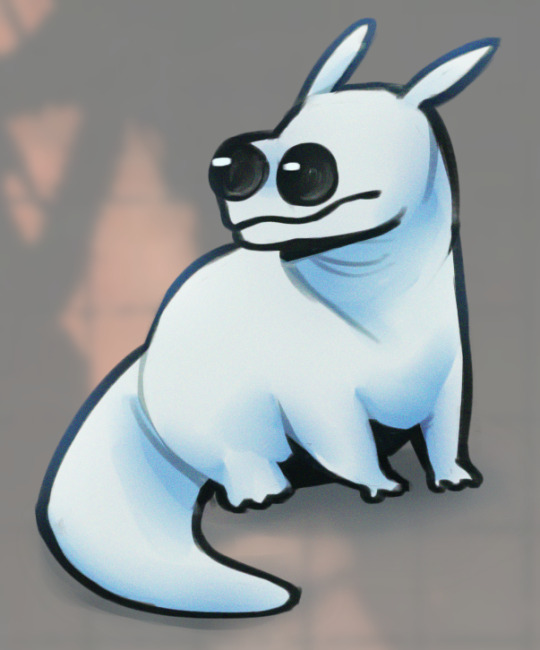
#my art#rain world#saint#gourmand#monk#survivor#posts more rain world art while you're not looking#points at slugs and lizards. weird ass cats i think#i started drawing tbh eyes as a joke. but guys i don't think it's a joke anymore#nips gets rounder every time i draw her#discovering fun new art techniques is easy. remembering to use them consistently however#posts completely unrelated art once a month like a farmer rotating her crops to keep the soil healthy#how in the world did i manage to stay focused on rainworld for like 6 months that one time#i want to play ace attorney so badly. but the brain worms#<- bg3 reference?
600 notes
·
View notes
Text
Getting emotional about the salmon run again…
#solarpunk#no but seriously the way the indigenous people light fires to welcome the salmon home#and then wait to harvest them till enough have passed by#and the bears eat the salmon and their bodies rot to feed the soil#and that grows new trees that nourish the indigenous people and transpire rain#that keeps the water cycle in motion and feeds the sea#like nooooo I can’t my heart#hopepunk#environmentalism#social justice#cottagepunk#community#optimism#bright future#climate justice#tidalpunk#ecosystem#salmon#bears#forests
174 notes
·
View notes
Text
University of California, Riverside, chemical and environmental engineering scientists have identified two species of bacteria found in soil that break down a class of stubborn “forever chemicals,” giving hope for low-cost biological cleanup of industrial pollutants.
These bacteria destroy a subgroup of per- and poly-fluoroalkyl substances, or PFAS, that have one or more chlorine atoms within their chemical structure, Yujie Men, an assistant professor in the Bourns College of Engineering, and her UCR colleagues, reported in the journal Natural Water.
Unhealthful forever chemicals persist in the environment for decades or much longer because of their unusually strong carbon-to-fluorine bonds. Remarkably, the UCR team found that the bacteria cleave the pollutant’s chlorine-carbon bonds, which starts a chain of reactions that destroy the forever chemical structures, rendering them harmless.
“What we discovered is that bacteria can do carbon-chlorine bond cleavage first, generating unstable intermediates,” Men said. “And then those unstable intermediates undergo spontaneous defluorination, which is the cleavage of the carbon-fluorine bond.”
Chlorinated PFAS are a large group in the forever chemical family of thousands of compounds. They include a variety of non-flammable hydraulic fluids used in industry and compounds used to make chemically stable films that serve as moisture barriers in various industrial, packaging, and electronic applications.
The two bacteria species – Desulfovibrio aminophilus and Sporomusa sphaeroides – identified by Men’s group are naturally occurring and are known to live in the subterranean microbiomes where groundwater may be contaminated with PFAS. For expedited cleanups, an inexpensive nutrient, such as methanol, could be injected into groundwater to promote bacterial growth. This would greatly increase the bacteria’s presence to destroy the pollutants more effectively, Men said. If the bacteria are not already present, the contaminated water could be inoculated with one of the bacterium species.
But what’s known about using microorganisms to clean up PFAS is still in its infancy, Men said. Her discovery shows great promise because biological treatments, if effective pollutant-eating microbes are available, are generally less costly and more environmentally friendly than chemical treatments. Pollutant-eating microbes can also be injected into difficult-to-reach locations underground.
Men’s latest PFAS study comes as the U.S. Environmental Protection Agency is promulgating new regulations to spur cleanups of PFAS-contaminated groundwater sites throughout the nation because these chemicals have been linked to a host of ill health effects, including cancer, kidney disease, and hormone disruptions.
#good news#nature#science#environmentalism#bacteria#pfas#pfas pollution#soil#soil microbes#microbiology#environment
367 notes
·
View notes
Note
Ok dude to a recent post of yours is have to know what other plants are sluts?
Rhododendron is the QUEEN of sluts. It will not STOP. Uprooting this fast-growing monstrosity is dick and half a ball because it has strong roots and woody stems; UK conservationists hate this stuff.
The most monstrous slut, Colonel War Crimes of the slut kingdom, is Giant Hogweed. Not ONLY is it voracious, not only is it huge, but this plant is NOXIOUS. You have to sequester it off when you see it and eradicate it in PPE. Actively dangerous just to stand around.
Other sluts are sitka spruces, mile-a-minuteweed, japanese honeysuckle, skunk cabbage... very aggressive invaders. The UK is under seige with invasive species since the island is REALLY unique in its soil chemistry. Once you deacidify it, you have a hard time fixing that.
#Funfact! Earthworms are invasive to America and they came from Europe/UK#American forests did not evolve for earthworms to break down leaf litter the way they do#The UK did#Im noticing that in the uk there's a theme of having large and small animals (humans worms hogs)--#That churn the soil in some way and the ecosystem really being built around that#So when you get a new plant that fucks with that cycle it causes brand new problems#Especially pioneer plants that would ANYWHERE ELSE help fix an environment#But moor and bog is *supposed* to be like this#Cw vulgar language#Bone babble
64 notes
·
View notes
Text
The born in Eastern Europe curse of knowing you were doomed from the start
#being told growing up that the west was an utopia thats got their shit together#and you spend your whole life dreaming of escaping your home country and finally getting to *live*#but then you grow older and maybe you travel a little and even study abroad and you read the news and you realise#that it's all a lie#no one got their shit together and the west is just as much of a shitshow except they have money and hide corruption better#and you're left with nowhere to go#double whammy when you're also queer#its just one of those days when you talk to your aunt who worked at a factory during soviet time and listening to her experiences#and realising that the cycle did not break the cycle is looming over your heaf#and also knowing that as a queer person you will be alone for it#personal#anyways fuck bulgaria this country will be the death of me and yet i dont want to die on foreign soil#i grew up here and yet i dont wanna grow old here too
217 notes
·
View notes
Audio
Matters Unknown - We Aren’t Just - Nubiyan Twist brass player Jonny Enser leading his own band, on the promising new(ish) label New Soil
MATTERS UNKNOWN is the new project led by multi-instrumentalist and composer Jonny Enser. The long-standing brass player for celebrated Afro-Jazz collective Nubiyan Twist has created We Aren’t Just, a wide-ranging double album that channels his concepts of living dynamism and communal practice through a prolific musical compendium. It boldly encompasses Afro-jazz, celestial blues, soulful funk, electronica, hip hop and more. At its heart is a personal response to the physical and mental pain he has experienced in his life as a musician confronting disability; a coping mechanism alchemised as a universal healing force.
Celestial blues wrapped in contemporary global grooves. Project and propel the tradition.
Jonathan Enser - MD, trumpet, tuba, synths, piano, percussion, producer
Matt Davies - Drums, Cymbals
Alec Hewes - Upright Bass, Electric Bass
Lyle Barton - Piano, Fender Rhodes, Keyboards, Synths
Rosie Turton - Trombone
Viva Msimang - Trombone
Olivia Bhattacharjee - Vocals
Matt Holborn - Strings
Jansen Santana - Percussion
Lewis Moody - Synth
Nick Richards - Vocals, Alto Sax
Tom Excell - Percussion
Joe Murgatroyd - Bass Clarinet
Nadeem Din-Gabisi - Vocals
Mohamed Gueye - Sabar
Artwork by Raimund Wong
3 notes
·
View notes
Text

been followin slimes POV of the qsmp since it started but mMY GOOOODDDDD i never expected to fall so in love with it...
I LOVE THE TRADGEDY OF A COMEDIC CHARACTER! so funny so silly, who could ever take him seriously? when the reaction to grief can be so overblown and strange, its hard not to laugh! because wheres the line, really? we're just here to have fun!
i look forward to the day this guy snaps! its gonna be REALLY FUNNY i tell ya hwat!!!
(CREDIT TO A COMIC I REFERENCED UNDER THE CUT)
something about this comic makes me so so emotional, and its so well framed. to discover something by the end of a comic, to follow the same line of thought as a character within a drawing, to either come to the same conclusion, or the dramatic irony of figuring it out first.
it was made by the talented Lynda Barry, and she has a wonderful shop here https://drawnandquarterly.com/books/greatest-marlys/
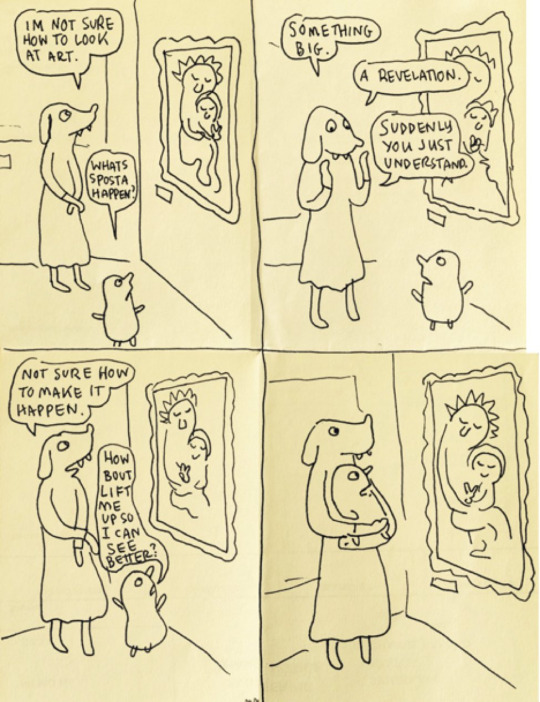
#q!slimecicle#qsmp#qsmp fanart#qsmp slimecicle#NOT MY FIRST TIME DRAWIN SLIMECICLE BUT ITS DEF BEEN A WHHHIILE. THIS IS HOWEVER MY FIRST TIME DRAWIN THE OTHERS#LIKE ive never drawn philza or cellbit or pol or bbh before. i looked up MINIMAL refs and went off their minecraft skins. hope yall like em#FUN FACTS! i gave q!slime the green flannel (but the green plaid is silent) bc of katastrophics design for him#he also has the 3 hearts n the Bra'ad sash bc OFFCCC u just cant see that gay lil bag here#maybe one day ill draw a qslime with more detail#IN OTHER NEWS ! this series fascinates me SOOO MUCH! THE FEDS AND THE CODES N THE EGGS AND WHAT DOES IT ALL MEAANN???#I HAVVEEE theories abt juanaflippa. SPOILER WARNING IG BUT IM ABT TO RAAAAMBLE!!#SO this totally isnt flippa right. like this is someone else. this is one of the code beasts piloting either a costume or a corpse#BOTH INTRIGUE ME. but nonetheless. this thing is NEW and it is LEARNING and it LOVES ITS DAD#ITS NOT FLIPPA BUT OHH HOW NICE IT IS TO BE FLIPPA! TO BE FED AND HUGGED AND LOVED SO SO SO MUCH#AND YET SOMETHING IS SO TERRIBLY WRONG. SOMETHING IS BLEEDING OUT AND INFECTING THE AIR AND SOIL AND SPACE#AND ITS HURTING CODEFLIPPAS DAD! ITS TURNING HIM INTO SOMETHING ELS.E. HE DOESNT CARE BUT CERTAINLY SOMEONE ELSE DOES#MAYBE THE PEOPLE AROUND HIM. BUT MOST CERTAINLY IT MUST BE EATING AT THIS POOR LITTLE CODE#THIS POISONOUS LITTLE THING. THIS DISEASE. THIS VIRUS. IT JUST WANTS TO BE HELD A LITTLE LONGER. BUT AT WHAT COST?
63 notes
·
View notes
Text
The drone attack in russia is getting more attention in the news than the attack of the russians on Odesa in Ukraine 🙃.
Attacks by the russians are becoming less "newsworthy" to the Western media. The attention to the horrible things that are happening in Ukraine every day is slowly slipping away.
#this is mostly about dutch news but I am sure something similar is happening in some other countries#attacks on russian soil is seen as something newsworthy#but attacks on Ukrainian cities are being seen in the West as “just another bombing”#it's being normalized almost? if that's the right word for it?#but it never should be#we shouldn't forget how horrible those bombings by the russians are#we shouldn't forget the suffering#Ukraine#russia#war#russian invasion#russia is a terrorist state
122 notes
·
View notes
Note
max with daniel https://www.tumblr.com/gulabsjamun/745332488921120768
giving daniel finally giving in and going home with max only for max to hit him with a 'i lied. there is no sex. put your clothes back on and listen to me list off all the bodies of water in alberta, canada in alphabetical order.'
#ask!#maxiel#pillow talk but it's him infodumping about what type of soil is most prevalent in new zealand or whatever the fuck#max/daniel
29 notes
·
View notes
Text
I love when people apply their subjects of study/work to a narrow part of tes lore. One of my favorite parts of this fandom
#learn new things AND engage with special interest!! what could be better!!!!!#anyway shout out to that soil post#and to the food posts i see form time to time#there is a phylogenetic tree and evolutionary history of the morrowind/skyrim beasties in my head that i need to put into the world someday#also i have an idea for unique soul gem powered and dwemer sewing machines but im not good enough at designed machinery for that#mine#tes#the elder scrolls#tesblr
42 notes
·
View notes
Photo

I love all of Soil That Binds Us but the Luci and Sunshine chapter is something truly amazing.
[ID: A gif of Luci and Sunshine sitting on top of a building, they stay still smiling at each other, Luci holds a sandwich without crusts. They are framed by a circle and in the rest of the image various illustrations fade in and out of view including lanterns, a rabbit, a syringe, Sunshine’s sunglasses, a bitten lemon, and parafacility masks.]
#flashing gif#flashing cw#luci lavender#sunshine xu#soil that binds us#trying something new with the gif we’ll see if I like it#fanart
103 notes
·
View notes